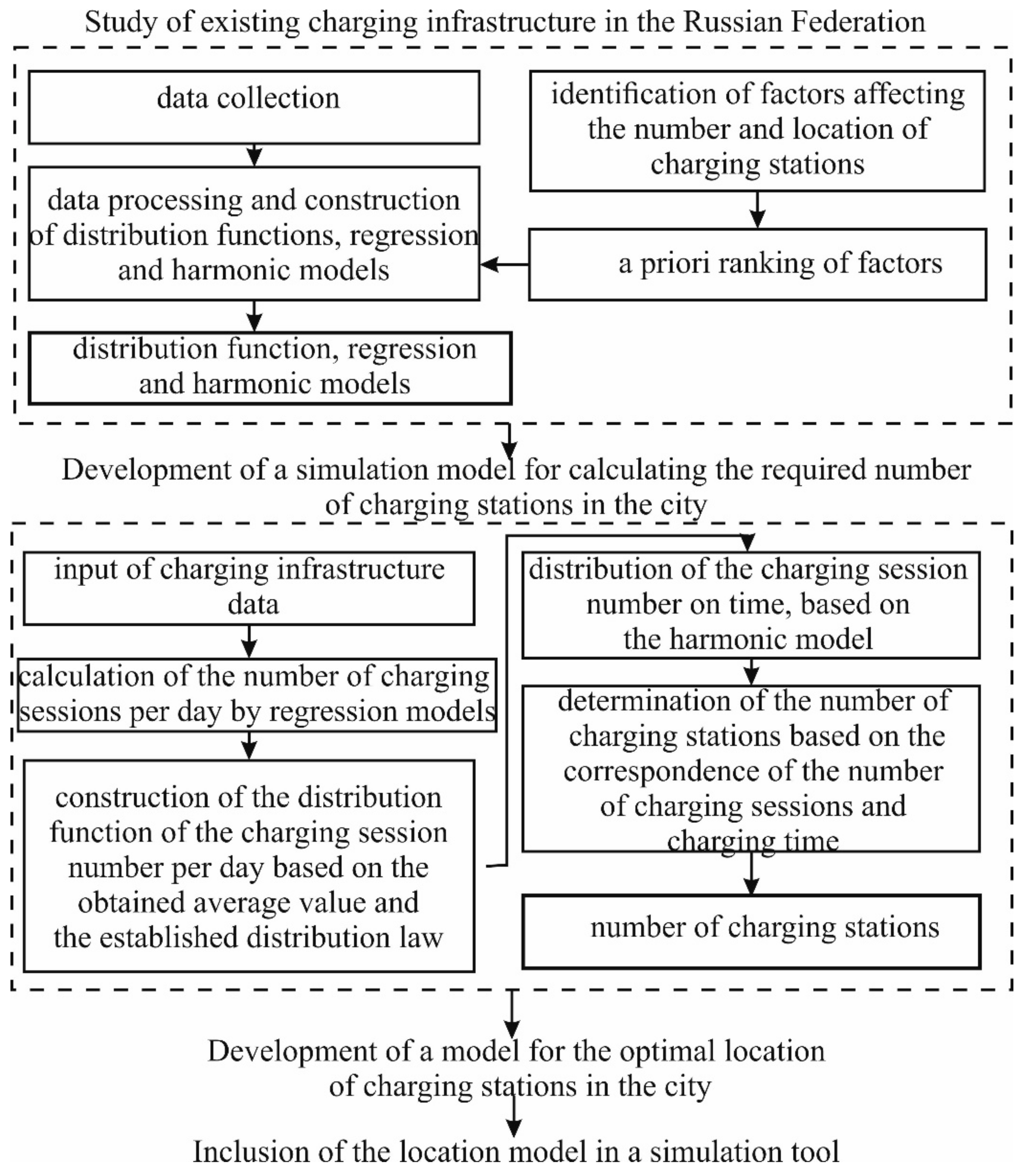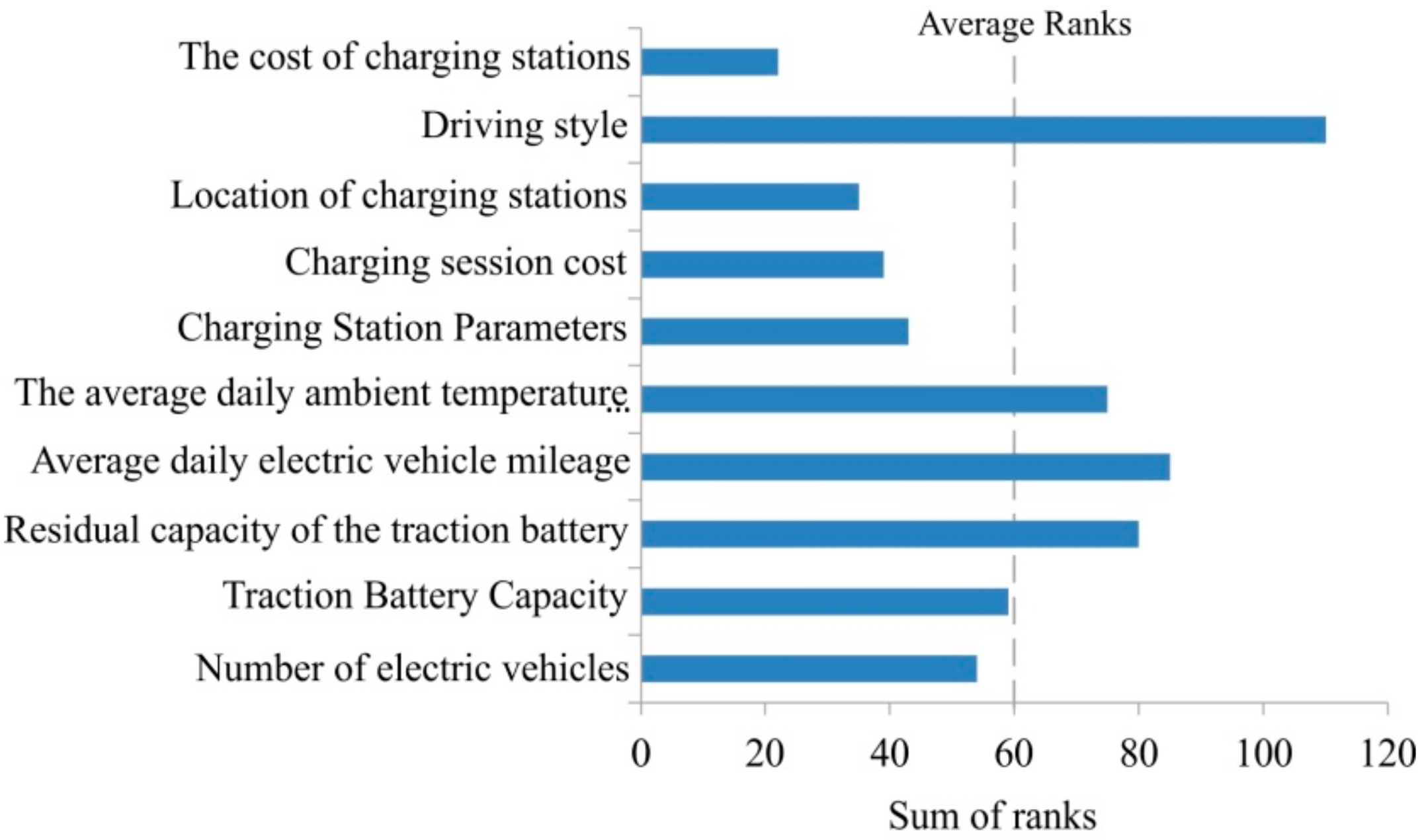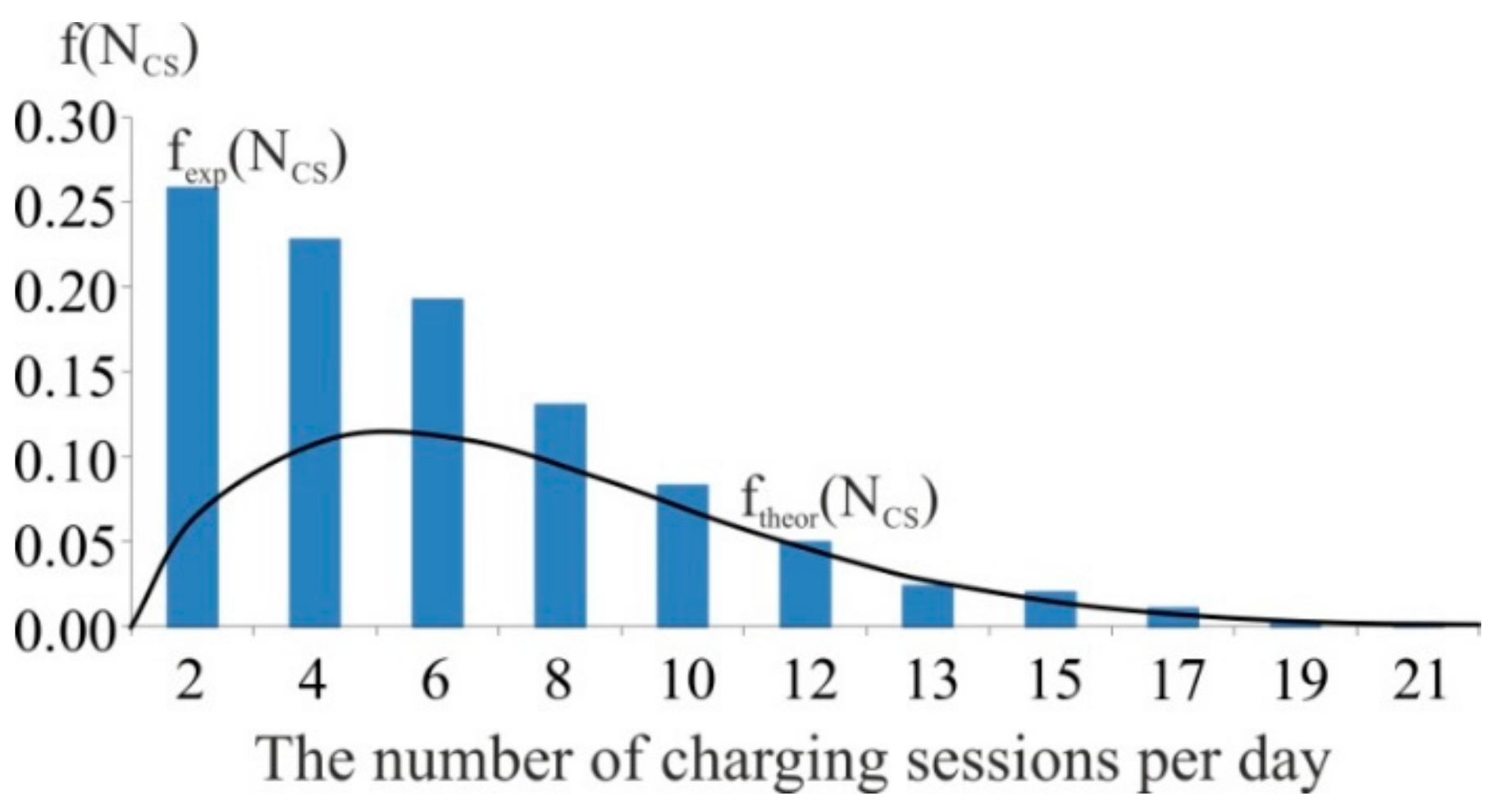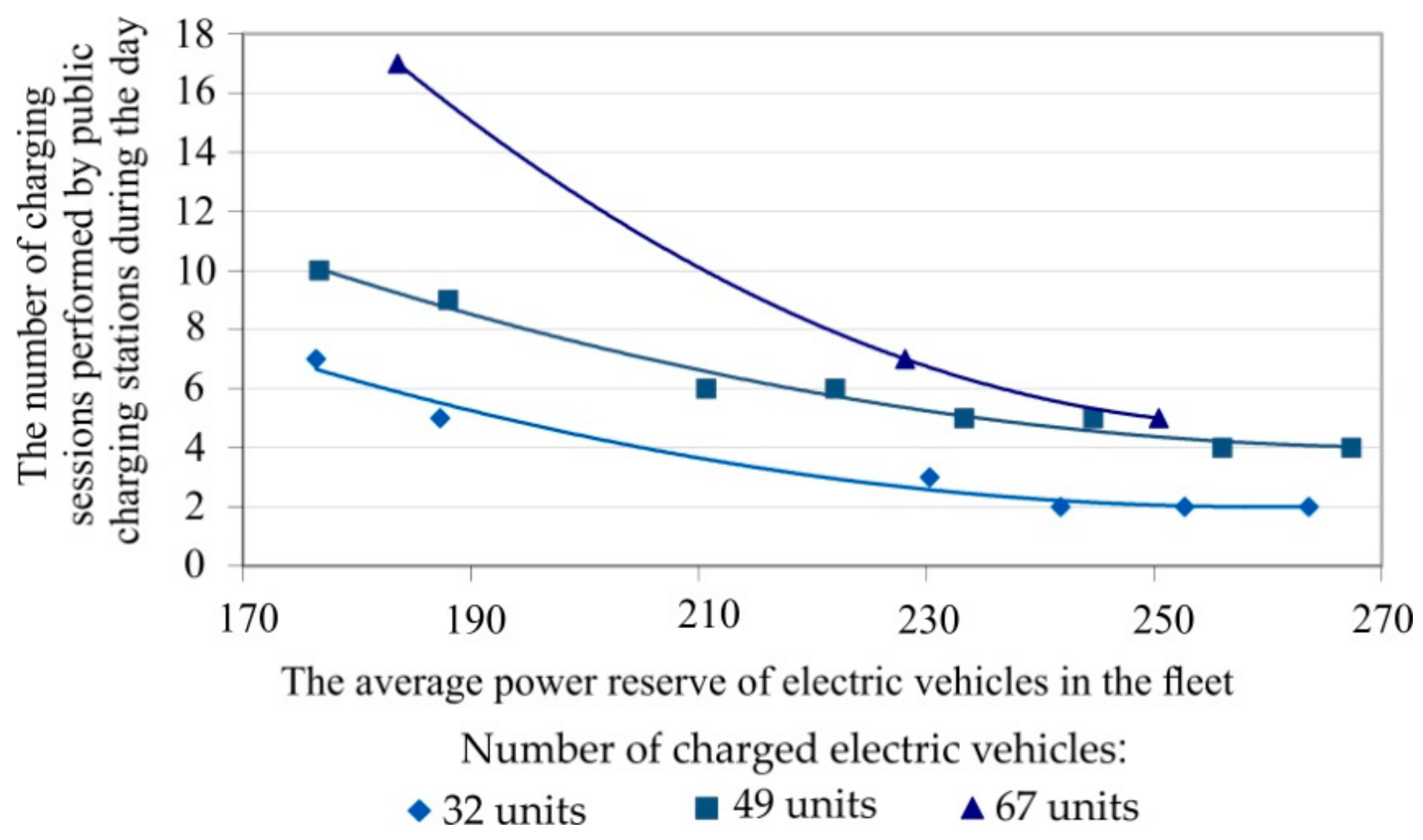Studying the Formation of the Charging Session Number at Public Charging Stations for Electric Vehicles
Abstract
1. Introduction
- minimization of the total costs when using the charging infrastructure;
- minimization of the operating costs for electric vehicle drivers;
- maximization of the demand coverage.
- calculation of the required number of charging stations on the basis of data on the existing charging infrastructure operation and a simulation model of its development;
- determining the location of the charging stations in the city on the basis of data on their quantity and development over time, features of the electric network (use of renewable energy sources), distance of coverage.
2. Materials and Methods
2.1. Research Methodology
2.2. The Methodology of the First Research Stage
- the number of charging sessions performed at various times of the day at public urban charging stations;
- brands, models and capacities of electric vehicle batteries;
- the number of electric vehicles that are charged from public charging stations.
- calculation of the minimum sample size;
- search of sampling errors by the Thompson criterion;
- determination of the interval number, grouping data;
- selection of the distribution law by type of histogram and obtained statistical characteristics;
- verification of the conformity of the theoretical law with the empirical Pearson criterion.
- determining the interval number and grouping data of the sample used to construct the distribution function;
- calculation of the minimum sample size for each study interval;
- search of sampling errors by the Thomson criterion;
- calculation of the expectation of the charging session number in each interval of the grouped data;
- development of patterns based on the data;
- choice of the general form of the regression equation;
- calculation of the coefficients for the regression equation;
- verification of the conformity of the regression equation with the initial data by the Fisher dispersion relation and the average approximation error;
- calculation of the correlation ratio and assessment of its significance according to the student criterion.
- calculating the utilization rate of the charging station at each time of the day (it is the probability of a charging session);
- determination of the parameters of each harmonic curve obtained by expanding the empirical series. These are amplitude, initial phase and period;
- linearization of the equation of each harmonic curve;
- verification of the conformity of the equation to the initial data by the Fisher dispersion relation and the average approximation error;
- calculation of the correlation ratio and assessment of its significance according to the Fisher criterion.
3. Results
3.1. A Priori Ranking of Factors
3.2. Distribution Function Describing the Change in the Number of Charging Sessions per Day
3.3. Regression Models
- number of electric vehicles in operation;
- cost of a charging session;
- capacity of electric vehicle batteries in the fleet.
3.4. Harmonic Model of Changing the Utilization Rate of the Charging Station
4. Discussion
5. Conclusions
- calculation of the required number of charging stations on the basis of data on the existing charging infrastructure operation and a simulation model of its development;
- determining the location of the charging stations in the city on the basis of data on their quantity and development over time, features of the electric network (use of renewable energy sources), distance of coverage.
Author Contributions
Funding
Acknowledgments
Conflicts of Interest
References
- Avtar, R.; Tripathi, S.; Aggarwal, A.K.; Kumar, P. Population-Urbanization-Energy Nexus: A Review. Resources 2019, 8, 136. [Google Scholar] [CrossRef]
- Genon, G.; Panepinto, D.; Viggiano, F.; Magaril, E.; Abrzhina, L.; Magaril, R. Sustainability in automotive transport: Russian and Italian experience concerning actual situation and intervention tools. Int. J. Sustain. Dev. Plan. 2016, 11, 603–615. [Google Scholar] [CrossRef]
- Stroe, C.-C.; Panaitescu, V.N.; Ragazzi, M.; Rada, E.C.; Ionescu, G. Some considerations on the environmental impact of highway traffic. Rev. Chim. 2014, 65, 152–155. [Google Scholar]
- Magaril, E.; Magaril, R. Fuel quality: Challenges to the sustainable development of automobile transport and approach to solution. E3S Web Conf. 2016, 6, 03001. [Google Scholar] [CrossRef]
- Ionescu, G.; Apostol, T.; Rada, E.C.; Ragazzi, M.; Torretta, V. Critical analysis of strategies for PM reduction in urban areas. UPB Sci. Bull. Ser. D Mech. Eng. 2013, 75, 175–186. [Google Scholar]
- Istrate, I.A.; Oprea, T.; Rada, E.C.; Torretta, V. Noise and air pollution from urban traffic. WIT Trans. Ecol. Environ. 2014, 191, 1381–1389. [Google Scholar] [CrossRef]
- Magaril, E. The solution to strategic problems in the oil refining industry as a factor for the sustainable development of automobile transport. WIT Trans. Ecol. Environ. 2014, 190, 821–832. [Google Scholar] [CrossRef][Green Version]
- International Renewable Energy Agency. Global Energy Transformation: A Roadmap to 2050 (2019 Edition); International Renewable Energy Agency: Abu Dhabi, UAE, 2019. [Google Scholar]
- Gitelman, L.; Magaril, E.; Kozhevnikov, M.; Rada, E.C. Rational behavior of an enterprise in the energy market in a circular economy. Resources 2019, 8, 73. [Google Scholar] [CrossRef]
- Panepinto, D.; Zanetti, M.C.; Gitelman, L.; Kozhevnikov, M.; Magaril, R.; Magaril, R. Energy from Biomass for Sustainable Cities. IOP Conf. Ser. Earth Environ. Sci. 2017, 72, 012021. [Google Scholar] [CrossRef]
- Al-Kayiem, H.H. Hybrid techniques to enhance solar thermal: The way forward. Int. J. Energy Prod. Manag. 2016, 1, 50–60. [Google Scholar] [CrossRef][Green Version]
- Burakova, A.D.; Burakova, L.N.; Anisimov, I.A.; Burakova, O.D. Evaluation of the operation efficiency of solar panels in winter. IOP Conf. Ser. Earth Environ. Sci. 2017, 72, 012022. [Google Scholar] [CrossRef]
- Anisimov, I.A.; Burakova, L.N.; Burakova, A.D.; Burakova, O.D. Assessment of a solar cell panel spatial arrangement influence on electricity generation. Iop Conf. Ser. Earth Environ. Sci. 2017, 66, 012007. [Google Scholar] [CrossRef]
- International Renewable Energy Agency. Electrification with Renewable. Driving the Transformation of Energy Services; International Renewable Energy Agency: Abu Dhabi, UAE, 2019. [Google Scholar]
- Kush-Brandt, S. Urban Renewable Energy on the Upswing: A Spotlight on Renewable Energy in Cities in REN21’s “Renewables 2019 Global Status Report”. Resources 2019, 8, 139. [Google Scholar] [CrossRef]
- Gavrikova, E.; Burda, E.; Gavrikov, V.; Sharafutdinov, R.; Volkova, I.; Rubleva, M.; Polosukhina, D. Clean Energy Sources: Insights from Russia. Resources 2019, 8, 84. [Google Scholar] [CrossRef]
- International Renewable Energy Agency. Renewable Capacity Statistics 2018; International Renewable Energy Agency (IRENA): Abu Dhabi, UAE, 2018. [Google Scholar]
- Gielen, D.; Boshel, F.; Saygin, D.; Bazilian, M.; Wanger, N.; Gorini, R. The role of renewable energy in the global energy transformation. Energy Strategy Rev. 2019, 24, 38–50. [Google Scholar] [CrossRef]
- Funke, S.; Sprei, F.; Ghann, T.; Plotz, P. How much charging infrastructure do electric vehicles need? A review of the evidence and international comparison. Transp. Res. Part D Transp. Environ. 2019, 77, 224–242. [Google Scholar] [CrossRef]
- International Renewable Energy Agency. Innovation Outlook: Smart Charging for Electric Vehicles; International Renewable Energy Agency: Abu Dhabi, UAE, 2019. [Google Scholar]
- International Renewable Energy Agency. Innovation Landscape Brief: Electric-Vehicle Smart Charging; International Renewable Energy Agency: Abu Dhabi, UAE, 2019. [Google Scholar]
- Rietmann, N.; Hugler, B.; Lieven, T. Forecasting the trajectory of electric vehicle sales and the consequences for worldwide CO2 emissions. J. Clean. Prod. 2020, 261, 121038. [Google Scholar] [CrossRef]
- International Renewable Energy Agency. The Renewable Route to Sustainable Transport: A Working Paper based on Remap; International Renewable Energy Agency: Abu Dhabi, UAE, 2016. [Google Scholar]
- Taljegard, M.; Goranssom, L.; Odenberger, M.; Johnsson, F. Impacts of electric vehicles on the electricity generation portfolio – A Scandinavian-German case study. Appl. Energy 2019, 97, 1637–1650. [Google Scholar] [CrossRef]
- Chen, L.; Wu, Z. Study on the effects of EV charging to global load characteristics via charging aggregators. Energy Procedia 2018, 145, 175–180. [Google Scholar] [CrossRef]
- Vosooghi, R.; Puchinger, J.; Bischoff, J.; Jankovic, M.; Vouillon, A. Shared autonomous electric vehicle service performance: Assessing the impact of charging infrastructure. Transp. Res. Part D Transp. Environ. 2020, 81, 102283. [Google Scholar] [CrossRef]
- Anisimov, I.A.; Burakova, A.D.; Burakova, L.N. Increasing the efficiency of electricity production from renewable source for charging electric vehicles. In Proceedings of the 2018 International Multi-Conference on Industrial Engineering and Modern Technologies, Vladivostok, Russia, 3–4 October 2018; p. 18393143. [Google Scholar] [CrossRef]
- Frade, I.; Ribeiro, A.; Goncalves, G.A.; Antunes, A.P. Optimal location of charging stations for electric vehicles in a neighborhood in Lisbon, Portugal. Trans. Res. Rec. J. Trans. Res. Board 2011, 2252, 91–98. [Google Scholar] [CrossRef]
- Daskin, M.S. What you should know about location modeling. Nav. Res. Logist. 2008, 405, 283–294. [Google Scholar] [CrossRef]
- Daskin, M.S. Network and Discrete Location. Models, Algorithms, and Applications, 2nd ed.; John Wiley & Sons: Hoboken, NJ, USA, 2013; pp. 124–362. [Google Scholar]
- Gimenez-Gaydou, D.A.; Ribeiro, A.N.; Gutierrea, J.; Antunes, A.P. Optimal location of battery electric vehicle charging stations in urban areas: A new approach. Int. J. Sustain. Trans. 2016, 10, 393–405. [Google Scholar] [CrossRef]
- Wang, Y.W.; Lin, C.C. Locating multiple types of recharging stations for battery-powered electric vehicle transport. Trans. Res. Part E 2013, 58, 76–87. [Google Scholar] [CrossRef]
- Lam, A.S.; Leung, Y.W.; Chu, X. Electric vehicle charging station placement: Formulation, complexity, and solutions. IEEE Trans. Smart Grid 2014, 5, 2846–2856. [Google Scholar] [CrossRef]
- Mak, H.Y.; Rong, Y.; Shen, Z.M. Infrastructure planning for electric vehicles with battery swapping. Manag. Sci. 2013, 59, 1557–1575. [Google Scholar] [CrossRef]
- Ko, J.; Shim, J.S. Locating battery exchange stations for electric taxis: A case study of Seoul, South Korea. Int. J. Sustain. Trans. 2016, 10, 139–146. [Google Scholar] [CrossRef]
- He, S.; Kuo, Y.H.; Wu, D. Incorporating institutional and spatial factors in the selection of the optimal locations of public electric vehicle charging facilities: A case study of Beijing, China. Trans. Res. Part C Emerg. Technol. 2016, 67, 131–148. [Google Scholar] [CrossRef]
- Ghamami, M.; Nie, Y.; Zockaie, A. Planning charging infrastructure for plug-in electric vehicles in city centers. Int. J. Sustain. Trans. 2016, 10, 343–353. [Google Scholar] [CrossRef]
- Hanabusa, H.; Horiguchi, R. A study of the analytical method for the location planning of charging stations for electric vehicles. In Proceedings of the Knowledge-Based and Intelligent Information and Engineering Systems, Kaiserslautern, Germany, 12–14 September 2011; Dengel, A., Hinkelmann, K., Eds.; pp. 596–605. [Google Scholar] [CrossRef]
- Dong, J.; Liy, C.; Lin, Z. Charging infrastructure planning for promoting battery electric vehicles: An activity-based approach using multiday travel data. Trans. Res. Part C 2014, 38, 44–55. [Google Scholar] [CrossRef]
- Cui, S.; Zhao, H.; Wen, H.; Zhang, C. Locating multiple size and multiple type of charging station for battery electricity vehicles. Sustainability 2018, 10, 3267. [Google Scholar] [CrossRef]
- Chen, T.D.; Kockelman, K. The electric vehicle charging station location problem: A parking-based assignment method for Seattle. Trans. Res. Rec. 2013, 13, 1254. [Google Scholar] [CrossRef]
- Dashora, Y.; Barnes, J.W.; Pillai, R.; Combs, T.; Hilliard, M.; Chinthavali, M. The PHEV Charging Infrastructure Planning (PCIP) Problem. Int. J. Emerg. Electr. Power Syst. 2010, 11, 2482. [Google Scholar] [CrossRef]
- Ge, S.; Feng, L.; Liu, H.; Wang, L. The planning of electric vehicle charging stations in the urban area. In Proceedings of the International Conference on Electronic & Mechanical Engineering and Information Technology (EMEIT-2012), Paris, France, 7 September 2012; Atlantis Press: Paris, France, 2012; p. 356. [Google Scholar] [CrossRef]
- Chen, C.; Hua, G. A new model for optimal deployment of electric vehicle charging and battery swapping stations. Int. J. Control Auto. 2014, 7, 247–258. [Google Scholar] [CrossRef]
- Wolbertus, R.; Hoed, R. Electric vehicle fast charging needs in cities and along corridors. World Electr. Veh. J. 2019, 10, 45. [Google Scholar] [CrossRef]
- Cruz-Zambrzno, M.; Corchero, C.; Igualada-Gonzalez, L. Optimal location of fast charging stations in Barcelona: A Flow-Capturing approach. In Proceedings of the 10th International Conference on the European Energy Market (EEM), Stockholm, Sweden, 27–31 May 2013; p. 13797585. [Google Scholar] [CrossRef]
- Nie, Y.; Ghamami, M. A corridor-centric approach to planning electric vehicle charging infrastructure. Trans. Res. Pat. B 2013, 57, 172–190. [Google Scholar] [CrossRef]
- Wang, Z.; Liu, P.; Cui, J.; Xi, Y.; Zhang, L. Research on quantitative models of electric vehicle charging stations based on principle of energy equivalence. Math. Prob. Eng. 2013, 2013, 959065. [Google Scholar] [CrossRef]
- Sweda, T.; Klabjan, D. An agent-based decision support system for electric vehicle charging infrastructure deployment. In Proceedings of the IEEE Vehicle Power and Propulsion Conference, Chicago, IL, USA, 6–9 September 2011; p. 12339422. [Google Scholar] [CrossRef]
- Farkas, C.; Prikler, L. Stochastic modelling of EV charging at charging stations. In Proceedings of the International Conference on Renewable Energies and Power Quality (ICREPQ’12), Santiago De Compostela, Spain, 28–30 March 2012; p. 574. [Google Scholar] [CrossRef]
- Li, R.; Su, H. Optimal Allocation of Charging Facilities for Electric Vehicles Based on Queuing Theory. Autom. Electr. Power Syst. 2011, 35, 58–61. [Google Scholar]
- Conti, V.; Orchi, S.; Valentini, M.; Nigro, M.; Calo, R. Design and evaluation of electric solutions for public transport. Transp. Res. Procedia 2017, 27, 117–124. [Google Scholar] [CrossRef]
- Fusco, G.; Alessandrini, A.; Colombaroni, C.; Valentini, M. A model for transit design with choice of electric charging system. Procedia Soc. Behav. Sci. 2013, 87, 234–249. [Google Scholar] [CrossRef][Green Version]
- Filippo, G.; Marano, V.; Sioshansi, R. Simulation of an electric transportation system at the Ohio State University. Appl. Energy 2014, 11, 1686–1691. [Google Scholar] [CrossRef]
- Abdulaed, E.K.; Makharatkin, P.N.; Pumpur, E.V. A priori ranking and an analysis of factors affecting tire wear. Iop Conf. Ser. Earth Environ. Sci. 2019, 378, 01200. [Google Scholar] [CrossRef]
- Podvazko, V.; Sivilevicius, H. The use of AHP and rank correlation methods for determining the significance of the interaction between the elements of a transport system having a strong influence on traffic safety. Transport 2013, 28, 389–403. [Google Scholar] [CrossRef]








| Factor | Points (From 1 to 10) |
|---|---|
| Number of electric vehicles in use | 7 |
| Traction battery capacity | 3 |
| Residual capacity of the traction battery | 6 |
| Average daily vehicle mileage | 9 |
| Average daily ambient temperature | 8 |
| Parameters of installed charging stations | 2 |
| Charging session cost | 4 |
| Location of charging stations | 5 |
| Features of driving an electric car (driver behavior) | 10 |
| The cost of charging stations | 1 |
| Statistical Characteristic | Value |
|---|---|
| Expectation, charging session per day | 5 |
| Variation coefficient | 0.61 |
| Skewness | 0.98 |
| Excess | 3.36 |
| Calculated value of the Pearson test | 139.71 |
| Critical value of the Pearson test | 2.92 |
| Statistic Characteristic, Model Parameter | Value for an Average Power Reserve | ||
|---|---|---|---|
| 181.2 | 222.0 | 242.4 | |
| Model parameter c, charge session/vehicle | 0.23 | 0.11 | 0.08 |
| Correlation coefficient | 0.95 | 0.97 | 0.94 |
| Determination coefficient R2 | 0.90 | 0.95 | 0.89 |
| Table value of student criterion tp | 2.78 | 2.78 | 3.18 |
| Calculated value of student criterion t | 6.72 | 8.80 | 4.81 |
| Fisher test Fp | 6.61 | 6.61 | 5.54 |
| Fisher Dispersion Ratio F | 8.59 | 17.6 | 6.12 |
| Average approximation error,% | 9.3 | 7.0 | 7.8 |
| Statistic Characteristic, Model Parameter | Value for EM Quantity | ||
|---|---|---|---|
| 32 | 49 | 67 | |
| Model parameter a, 1/charging session | −0.564 | −0.227 | −0.300 |
| Model parameter b, 1/(km charging session) | 0.004 | 0.002 | 0.002 |
| Correlation coefficient | 0.96 | 0.95 | 0.99 |
| Determination coefficient R2 | 0.92 | 0.91 | 0.97 |
| Table value of student criterion tp | 2.78 | 2.44 | 4.30 |
| Calculated value of student criterion t | 6.87 | 7.64 | 5.98 |
| Fisher test Fp | 4.54 | 3.78 | 18.51 |
| Fisher Dispersion Ratio F | 10.67 | 9.38 | 24.5 |
| Average approximation error,% | 8.49 | 7.12 | 6.71 |
| Study | Method of the Charging Stations Number Calculation | Factors Taken into Account in the Calculation | Advantages | Disadvantages |
|---|---|---|---|---|
| (Wang, Z.; Liu, P.; Cui, J.; Xi, Y.; Zhang, L. 2013) | Method of energy equivalence. | Daily fuel sales at gas stations. Daily electricity sales at charging stations. Coefficient of proportionality. Number of gas stations. Average fuel consumption per 100 km by vehicle. | The method enables determining the maximum amount of energy consumed by electric vehicles in the absence of traditional vehicles. | The method does not ensure the development of a plan for the phased development of the charging infrastructure in accordance with the increase in the number of operated electric vehicles. |
| (Gimenez-Gaydou, D.A.; Ribeiro, A.N.; Gutierrea, J.; Antunes, A.P. 2016) | Calculation method based on the image of a potential electric vehicle owner | Education. Income. Gender. Age. Average travel distance per day. Number of vehicles in the household. | The method enables determining the optimal number of charging stations in the city during a gradual transition to electric vehicles | The method is static. The collection and processing of initial data for the calculation is difficult. |
| (Frade, I.; Ribeiro, A.; Goncalves, G.A.; Antunes, A.P. 2011) | Method for calculating the number of charging stations taking into account demand | Number of vehicles in the household. Number of vehicles/electric vehicles in various areas of the city. Average tavel distance during the day. Average power reserve of electric vehicles. | The method enables determining the optimal number of charging stations in the city during a gradual transition to electric vehicles | The method is static. The collection and processing of initial data for the calculation is difficult. |
| (Sweda, T.; Klabjan, D. 2011) | Method for calculating the number of charging stations based on agent modeling | Data on population movements in the city. Likelihood of verbal advertising influencing the acquisition of an electric vehicle by a new owner. Layout of the places of work and rest of the population. | The method is dynamic and provides the opportunity to develop several scenarios for the development of charging infrastructure in the gradual transition to electric vehicles. | Source data collection is difficult |
| (Farkas, C.; Prikler, L. 2011) | Method for calculating the number of charging stations based on stochastic modeling | Intensity of electric vehicles at charging stations. Charging time. | The method is dynamic and enables adjusting the parameters of charging stations, as well as determining their optimal number in different conditions. | In this article, the intensity of electric vehicle for charging and the charging time are accepted on the basis of theoretical laws. |
| (Li, R.; Su, H. 2011) | Method for calculating the number of charging stations based on the theory of queuing systems | Number of electric vehicles charged from the charging infrastructure. Average power consumption by an electric vehicle. Average daily mileage of electric vehicles. Electric vehicle battery capacity. Time required for electric vehicle to enter and exit from the charging station. Average charge time of an electric vehicle. | The method takes into account data on the fleet of electric vehicles and provides for minimizing the cost of building infrastructure with a gradual transition to electric vehicles. | The method does not provide accounting for the stochastic process of functioning of the charging infrastructure. |
© 2020 by the authors. Licensee MDPI, Basel, Switzerland. This article is an open access article distributed under the terms and conditions of the Creative Commons Attribution (CC BY) license (http://creativecommons.org/licenses/by/4.0/).
Share and Cite
Gorbunova, A.; Anisimov, I.; Magaril, E. Studying the Formation of the Charging Session Number at Public Charging Stations for Electric Vehicles. Sustainability 2020, 12, 5571. https://doi.org/10.3390/su12145571
Gorbunova A, Anisimov I, Magaril E. Studying the Formation of the Charging Session Number at Public Charging Stations for Electric Vehicles. Sustainability. 2020; 12(14):5571. https://doi.org/10.3390/su12145571
Chicago/Turabian StyleGorbunova, Anastasia, Ilya Anisimov, and Elena Magaril. 2020. "Studying the Formation of the Charging Session Number at Public Charging Stations for Electric Vehicles" Sustainability 12, no. 14: 5571. https://doi.org/10.3390/su12145571
APA StyleGorbunova, A., Anisimov, I., & Magaril, E. (2020). Studying the Formation of the Charging Session Number at Public Charging Stations for Electric Vehicles. Sustainability, 12(14), 5571. https://doi.org/10.3390/su12145571






